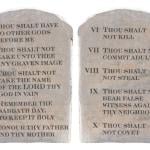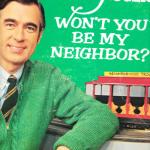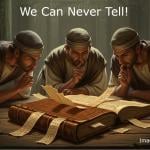From August 16, 2012, “Genre matters: The Bible and the Dewey Decimal system”
Ten years ago I was already seething with frustration over newspaper boilerplate that described the Left Behind series as “the prophecies of Revelation come true” or as “based on a literal reading of Revelation.” Gaaah! No. The series attempted to be based on the prophecies its authors said they got from John’s Apocalypse, but their convoluted scheme was not something any reader would find in the Bible.
“Premillennial dispensationalism” is not something that comes from the Bible. It’s something that is done to the Bible. And unless you’ve studied it’s psychedelic charts and graphs, you’ll never be able to navigate the way it requires you to hop, skip, and jump around from Revelation to Daniel to Matthew to Ezekiel, cutting and pasting together a narrative of “prophecy” and disregarding most of those texts when they refuse to fit into this framework.
Calling that process “reading” makes me cross. Claiming that process is “a literal reading” gives me the howling fantods.
The grifters marketing this 19th-century innovation claimed that they were the foremost experts on “Bible prophecy” and duped much of the media into accepting and repeating this claim. Worse, they convinced most observers to accept that their teaching was the most orthodox and the most “conservative.” After all, they and they alone had the conviction to accept a “literal interpretation,” unlike the squishy liberals and apostates who deviated from that original, literal truth, straying into alternate interpretations that claimed some biblical writers employed — gasp! — metaphors. Only faithless, pointy-headed academics, obviously, would ever suggest that writing and reading ever involved such a thing.
Even worse, though, was seeing this same presumption of authority and “conservative” orthodoxy applied to Ken Ham’s creationist scams. Accepting his own claims about himself at face value led many to parrot his claims that his weird, selective, incoherent departure from centuries of prior interpretation was “literal” and, therefore, correct and, therefore, authoritative and superior to every other approach to actually reading the actual text.
Bristling at that led to a flurry of testy, impatient posts here 10 years ago today. The first of these is the one republished below, followed by these three:
- “A hermeneutic walks into a bar …“
- “Second verse, same as the first …“
- “Ken Ham’s biblical exegesis is just as sound as his science“
For a friendlier discussion of the same general point, let me recommend this recent Twitter thread from @RabbiHarvey.
The Bible is a book.
It’s a bunch of books, actually, a bunch of different books written at different times by different people for different purposes. A bunch of different books in different genres.
The Dewey Decimal system acknowledges this, offering a classification for the Bible as a whole (220) and for a (somewhat inadequate) series of sub-categories, numbered 221-229.
But if you didn’t know that the books of the Bible were the books of the Bible, the Dewey Decimal system would have you running all over the library trying to figure out how to classify this odd pile of texts. Some of them, I suppose, should get shelved at 892 (“Afro-Asiatic literatures: Semitic”) while others should find a home in section 933 (“History of ancient world: Palestine”) but in several cases you’d be hard pressed to figure out which was which.
Quite a few of these smaller volumes could be shelved as 886 (“Classical Greek letters”). But then a handful should probably just be shelved as 880 (“Hellenic literatures; Classical Greek”) since they contain such a mix of elements that you could make a case for classifying them as 883, 885, 887 or 933. And if we don’t count the very special place the Dewey Decimal system provides for John’s Apocalypse (228), then it would be hard to know what to do with such a book, since apocalypses — a genre unto itself — don’t really have a home in Dewey’s system.
The good news is that this is only a hypothetical exercise and you won’t ever really have to go off into the stacks with a cart of 66 books, some of which defy easy classification.
The bad news is that if you want to read those 66 books, then you’ll still need to figure all that out. You need to figure out what kind of books these are because unless you know what kind of book you’re reading, you won’t know how to read it.
Generally, this is something we do almost unconsciously. We understand that there are different genres and different kinds of texts, and we’re usually pretty good at allowing the kind of text to provide the context for what we’re reading.
Thus if you were waiting in line at the store and you saw a headline reporting that “Obama Meets With Space Aliens,” you would react differently if that headline were in the Weekly World News than you would if it were in The New York Times. You realize, I hope, that the Times makes factual claims that it attempts to support and to confirm through investigation, while the Weekly World News makes the most outrageous claims it can dream up in the hopes of getting you to buy a copy on your way out of the store. If the latter reported on space aliens at the White House, you would ignore it. If the former reported the same thing, you would be excited because something important has just happened (either space aliens have landed, or the Times has lost its collective mind — either one would be Big News).
Sadly, not everyone is able to make the distinction between the contrasting genres of supermarket tabloids and actual newspapers, nor does everyone understand that these different sorts of texts need to be read differently.
Bookstores and libraries help us by separating texts by genre — fiction over there, history over there, biography there, and so on. But an experienced reader won’t need to rely on such assistance to figure out what sort of book they are reading. Quite often you can figure it out from the very first lines. “Once upon a time,” you read, and you can guess this is a fairy tale or a children’s story.
“Once upon a time and a very good time it was there was a moocow coming down along the road and this moocow that was coming down the road met a nicens little boy named baby tuckoo,” you read, and you may still be guessing it’s a children’s story, even though the title made it sound like it would be a biography. (In the case of that particular book, that guess would be wrong, but you’d probably figure that out before the end of the first chapter.)
But here is one of my great frustrations: many readers, just like the Dewey Decimal system, treat the Bible as a special case unto itself. They treat the Bible as its very own genre, disregarding all the indicators its many books themselves provide about what kinds of texts they actually are. Or they treat the Bible as though it somehow is a text that has no genre.
And when you read without regard for genre then you’re bound to misread whatever it is you’re reading.
This is a problem for some individual readers of the Bible, but the larger problem is that some of the loudest and most visible self-proclaimed “experts” on the Bible are themselves misreading it, and misrepresenting it, and thereby causing others to misread it as well, and to reject it on the basis of that misreading.
My complaint here is not that these latter readers don’t value the Bible the way that I do, but that they have been convinced — misled — to dismiss it for reasons that have more to do with the misreadings of those purported “experts” than with the actual book itself.
I’m kind of psyched for Peter Jackson’s first installment of The Hobbit later this year. My wife won’t be going with me to see it because she’s doesn’t much care for the fantasy genre. She doesn’t enjoy movies with hobbits and elves in them. Fair enough — she recognizes the genre and she doesn’t like it.












